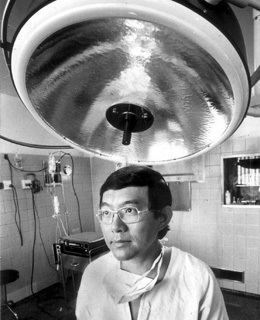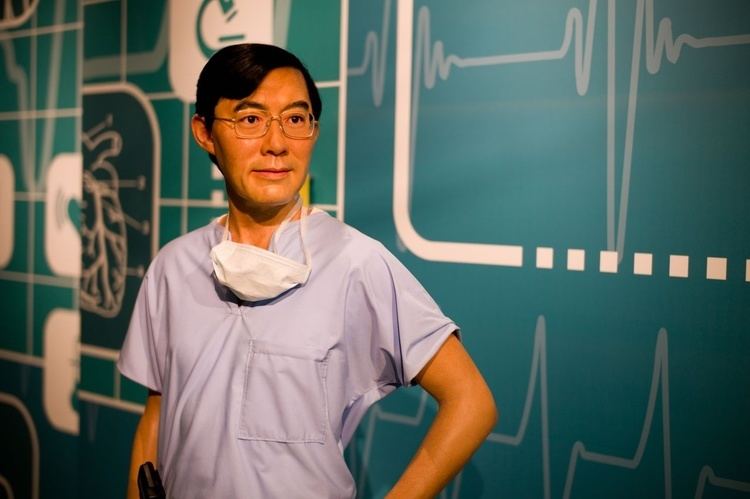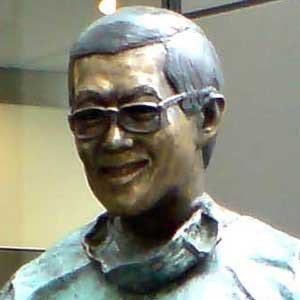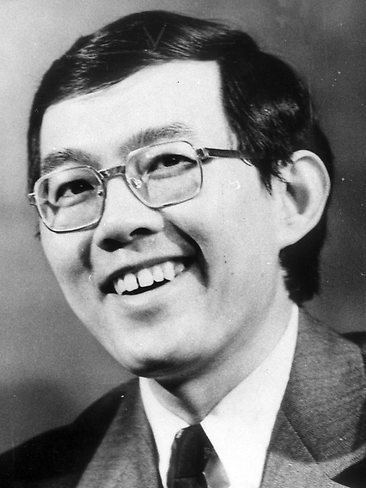Nationality Australian Name Victor Chang Parents May Chang, Aubrey Chang | Profession Surgeon Spouse Ann Simmons (m. ?–1991) Years active 1960–1991 Role Surgeon | |
 | ||
Specialism Cardiothoracic surgeryHeart transplantation Siblings Anthony Chang, Frances Chang Children Matthew Chang, Marcus Chang, Vanessa Chang | ||
Victor Chang Cardiac Research Institute
Victor Peter Chang (real name: Victor Leslie Peter Chang) , AC (born Chang Yam Him; 21 November 1936 – 4 July 1991), was a Chinese-Australian cardiac surgeon and a pioneer of modern heart transplantation. Born in Shanghai to Australian-born Chinese parents, he grew up in Hong Kong before moving to Australia. After completing his medical studies at the University of Sydney and working in St Vincent's Hospital, he trained in the United Kingdom and the United States as a surgeon before returning to Australia. In St Vincent's Hospital, he helped establish the National Cardiac Transplant Unit, the country's leading centre for heart and lung transplants. Chang's team had a high success rate in performing heart transplantations and he pioneered the development of an artificial heart valve.
Contents
- Victor Chang Cardiac Research Institute
- Victor chang
- Early life and education
- Medical training
- Surgical career
- Death
- Trial
- Legacy
- Personal life
- References

In 1986, he was appointed a Companion of the Order of Australia for his "service to international relations between Australia and China and to medical science". In 1991, Chang died after being shot in a failed extortion attempt against him. His legacy includes the creation of the Victor Chang Cardiac Research Institute, being voted Australian of the Century at the People's Choice Awards, and the establishment of the Victor Chang Lowy Packer Building in St Vincent's Hospital.

Victor chang
Early life and education
Chang was born in Shanghai to Australian-born Chinese parents. He grew up in Hong Kong, where he attended primary school in Kowloon Tong and spent two years in St. Paul's College. Chang's father Aubrey sent him and his younger sister to Sydney, Australia, in 1951 to stay with extended family. Chang attended Belmore Boys' High School in Belmore and completed his secondary education at Christian Brothers' High School in Lewisham. On 7 April 1948, Chang's mother died from breast cancer at the age of 33, prompting him to consider a career in medicine at the age of 12. He undertook his tertiary education at the University of Sydney, where he graduated with a Bachelor of Medical Science with First-Class Honours and a Bachelor of Medicine, Bachelor of Surgery in 1962.
Medical training

After completing his medical education, Chang interned at St Vincent's Hospital under the tutelage of cardiac surgeon Mark Shanahan who sent him to London to train with British surgeon Aubrey York Mason.

Chang became a Fellow of the Royal College of Surgeons in 1966 and trained in cardiothoracic surgery at the Royal Brompton Hospital. In London, he met and married his wife Ann (née Simmons).

Chang spent two years in the United States at the Mayo Clinic and became chief resident. In 1972, he returned to St Vincent's Hospital, where he was a consultant cardiothoracic surgeon and was appointed Fellow of the Royal Australasian College of Surgeons in 1973 and Fellow of the American College of Surgeons in 1975.
Surgical career

In St Vincent's Hospital, he worked with surgeons Harry Windsor (who had performed Australia's first heart transplant in 1968) and Mark Shanahan. The advent of anti-rejection drugs in 1980 made heart transplants more feasible, and Chang lobbied politicians and businessmen to raise funds to establish a heart transplant program at St. Vincent's. On 8 April 1984, a team of doctors led by Chang operated on 14-year-old Fiona Coote who became Australia's youngest heart transplant patient.

Between 1984 and 1990, Chang's unit performed over 197 heart transplants and 14 heart-lung transplants. The unit had a high rate of success with 90% of those receiving transplants from the unit surviving beyond the first year. In 1986, Victor Chang was appointed a Companion of the Order of Australia (AC) "in recognition of service to international relations between Australia and China and to medical science".
Concerned about a shortage of organ donors, he arranged financing and assembled a team of scientists and engineers from around the world to develop an artificial heart. That team, working in Singapore, Guangzhou and Sydney, also developed mechanical and tissue heart valves called the St. Vincent's Heart Valves, which were widely implanted throughout Asia. Chang and his team also made significant progress on the design of an artificial heart. His research projects ended with his death.
Death
On 4 July 1991, Chang was shot twice in the head in a failed extortion attempt. His body was found slumped in the gutter next to his car in the Sydney suburb of Mosman. Two Malaysian men, Chew Seng (Ah Sung) Liew and Choon Tee (Phillip) Lim, ran their car into Chang's vehicle, forcing him to pull over. After getting into an argument with Chang who refused to give them money, Liew fired the fatal shots; the first entered near the right cheek and exited below the right ear, while the fatal second, fired from point-blank range, entered the right temple and passed through the brain. Police investigators initially suspected the involvement of Triad syndicates, but later concluded the killing was an amateur act.
Trial
Liew pleaded guilty and was sentenced to 36 years in prison with a non-parole period of 14 years. Lim, who pleaded not guilty and claimed he did not know Liew had a gun, received a minimum to maximum sentence of 18 to 24 years. Another man, Stanley Ng, abandoned an extortion plan a day before the murder. He had unsuccessfully tried detaining Chang twice to force him to give AUD$3 million. Ng was granted immunity for his evidence. The prosecution alleged the plan had been to abduct Chang, tie him up with his family at his home in Clontarf, and threaten to hang them to coerce Chang into withdrawing money from the bank. In his ruling, Supreme Court Judge John Slattery stated, "It was an absurd, improbable plan, always doomed to failure".
On 26 October 2009, Lim was awarded parole. Following a public outcry and objection by the New South Wales Corrective Services Minister, John Robertson, his release was put on hold, pending another parole hearing. In the New South Wales Supreme Court, that decision was quashed due to the Parole Authority making a procedural error. Lim was freed from Parramatta Correctional Centre on 1 March 2010 into the custody of immigration officers. He was to be deported back to Kuala Lumpur, Malaysia, on 2 March, but the flight was cancelled for technical reasons. He was flown out of Australia on 3 March.
After 21 years in prison, Liew was granted parole and deported to Malaysia on 13 October 2012. In his parole hearing, he made a broad apology for the crime and believed that his long term in prison had taken effect. There was a small outcry from NSW Attorney-General Greg Smith; however, this was retracted and Liew was released from prison on 12 October 2012.
Legacy
On 15 February 1994, the Victor Chang Cardiac Research Institute, a body intended to focus on researching "the prevention, diagnosis and treatment of heart muscle diseases", was launched by Prime Minister Paul Keating with Kerry Packer as its patron. The "Dr Victor Chang Science Labs" in Christian Brothers' High School are named after him. In 1999, Prime Minister John Howard announced Chang as Australian of the Century at the People's Choice Awards after a decision between two Australian larrikins and two lifesavers. Swimmer Dawn Fraser, cricketer Donald Bradman, and ophthalmologist Fred Hollows were other contenders.
In St Vincent's Hospital, the Victor Chang Lowy Packer Building was established in 2008 with $35 million from the state government and $45 million in corporate and private donations. Mary, Crown Princess of Denmark officially opened the building and declared that Chang "was an original thinker and saw the need for research and the development of heart assist devices and, not least, he is known for his legendary caring for his patients and their families". In Time magazine's "A Golden Anniversary" article, which lists people who have shaped the last "50 Years in the South Pacific" (1959–2009), Chang was listed as the figure of 1979–1989.
Personal life
Chang met his wife Ann Simmons in 1966. He was the on-call emergency physician at St. Anthony's Hospital in North Cheam, London, where Ann took herself after being taken unwell at a party. They had three children: Vanessa, Matthew, and Marcus. Chang had two younger siblings: sister Frances and brother Anthony. He was irreligious but was known to ask Sister Bernie to say a prayer for his patients and was known for his compassion.
